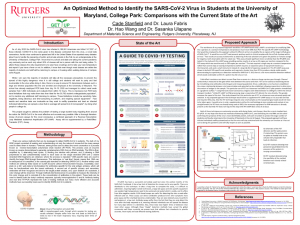Stanfield, Cade: “An Optimized Method to Identify the SARS-CoV-2 Virus in Students at the University of Maryland, College Park: Comparisons with the Current State of the Art
Title:An Optimized Method to Identify the SARS-CoV-2 Virus in Students at the University of Maryland, College Park: Comparisons with the Current State of the Art
Name: Cade Stanfield
Home Institute: University of Maryland, College Park
Programs: RISE program, REU – Green Energy Technology Undergraduate Program (GET UP)
Other contributors: Laura Fabris, Hao Wang and Sasanka Ulapane
Abstract: Identifying an optimal testing platform for the SARS-CoV-2 virus on large college campuses works to not only keep schools open but their students healthy. This project will fall under the advanced materials and bioengineering thrusts of GET UP. Researchers around the globe have developed assays specific to SARS-CoV-2 and resultant antibodies, but none are specific for a large university in a highly populated urban center. My approach leveraged the fundamental knowledge at the basis of successful COVID-19 diagnostic assays to propose a combined method that would work best in the college environment. To accomplish this goal, I identified the constraints that needed to be met by this innovative detection method and found the approach that met needs while conveying why my chosen approach was best for UMD. I read numerous papers detailing successful diagnostic strategies as well as many other online sources to better understand virology, bioengineering, and the methods of identifying viral RNA and antibodies. Regular meetings with Dr. Fabris and her post-docs were invaluable. I organized my notes onto a single document to compare methods with desired facets of an assay for UMD. I determined that during the initial return to campus an RT-LAMP assay that can detect the orf1ab gene of SARS-CoV-2 should be the primary diagnostic tool. This would be supplemented by a field effect transistor (FET)-based assay which detects the virus’s spike protein. The LAMP assay can be used to deal with large volumes of tests like in the first couple of weeks of students returning since it is fast, easy to read and administer, and accurate. The FET assay can supplement the LAMP assay, to provide more confidence in results. This would provide an extremely sensitive and swift COVID-19 test to anyone who wants one, limiting viral spread.
Biography: Cade Stanfield is a senior studying chemistry with a history minor at the University of Maryland, College Park. He was born in Annapolis, MD but lived his whole life before college on Kent Island in the small town of Stevensville, MD. He has been awarded the Dean’s Scholarship from the University of Maryland 3 times as well as several scholarships from his high school and organizations on the eastern shore of Maryland for community service and academic achievement. He has been on the Dean’s list 4 times. During his time at the University of Maryland, Cade has committed to developing a novel biopolymer for increasing the shelf life of produce with his research team in the school’s Gemstone program. He has also worked as a TA for Gemstone courses twice while maintaining a position on the steering committee which designs the first Gemstone course freshmen take. In addition to this, Cade worked on a research team which sought to identify colored dissolved organic matter in the Chesapeake Bay using spectroscopic techniques, a project with NASA consulting. Cade intends to pursue research and a master’s degree in chemistry after his undergraduate career and hopefully earn a PhD one day.
